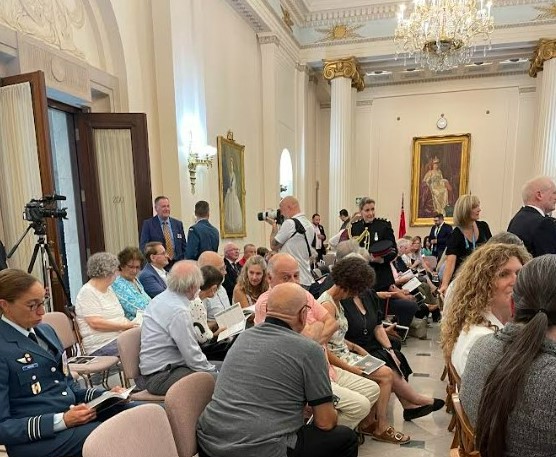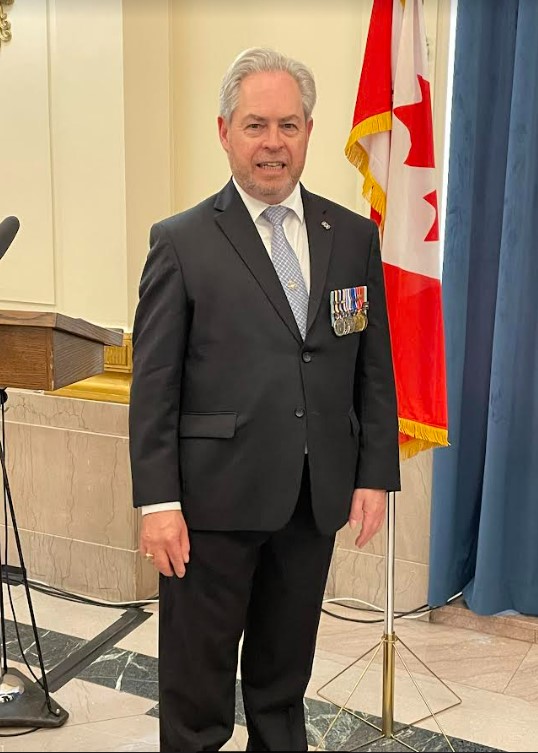
Tracking the Relatives of WWII Covert Operations Veterans
By Kathleen Kristjansson, MGS #5193
MGS Research Team
Are you aware of the Winnipeg connection to James Bond? Perhaps you have heard of the man, code named ‘Intrepid’, born William Samuel Clouston Stanger in this city in 1897. After his father’s death, he was adopted by Vigfus and Kristin Stephenson, and raised in the Point Douglas neighbourhood.
He enlisted in WWI, and became a decorated fighter pilot. He survived, and eventually settled in London, England, where he established the Business Industrial Secret Service, leading to contact with the British Secret Intelligence Service (SIS). Stephenson later moved to New York to become the director of British Security Coordination. In this capacity, he relayed scientific secrets to Franklin D Roosevelt and Winston Churchill, and established a training camp in Coburg, Ontario, for agents of Britain, and the United States Special Operations Executive. After the war, he was knighted by King George VI, and given the Order of Canada. Sir William Stephenson Lake, in Manitoba, was named in his honour.
He is but one of the courageous men and women, with connections to our province, to have been involved with the Special Operation Executive (SOE).
In 2020, Jim Rutherford, then Chair of the MGS Research Committee, was contacted by Lt. Colonel Robert Nash, on behalf of the Canadian Military Intelligence Association (CMIA). Would MGS be able to assist in locating living family members of a group of WWII veterans? Jim agreed, and his successor, Rick Walker, continued the involvement, after Jim’s death.
The CMIA advocates on behalf of its veterans, members of the Special Operations Executive, and educates people on the history of Canadian military intelligence. The original intent of Lt. Colonel Nash’s project was to include living relatives of this particular group of veterans, in a ceremony to dedicate a plaque honouring their service. Covid delayed the project by a couple of years.
Research Committee members divvied up the names of the men, who served, for the most part, with the Royal Canadian Air Force. Over two years, mixed in with their regular files on behalf of MGS, research committee members followed parents, siblings, children, and cousins all over Canada, and other parts of the world, looking for leads. It became apparent that, for the most part, there would be few living people with personal knowledge of the veterans. By using the census, voters lists, diverse newspapers, google, and even 411 phone listings, one by one, connections to the veterans were found, and handed over to Lt. Colonel Nash.
On one occasion, a connection to a veteran’s family was made through a researcher’s former work colleague, recognizing that a last name being sought, matched a person they’d both worked with. It took some time, but the connection was made.
It was gratifying to see a group of about 100 excited people making their way through the construction surrounding the Manitoba Legislature on the day of the unveiling ceremony. The crowd stood to welcome in Lieutenant-governor, Anita Neville. Trooping of the flags, prayers, acknowledgement of the Treaty territory, and an indigenous singer accompanying himself with a hand-held drum, set the tone of the inclusive ceremony.
One by one, the names of the veterans were announced. There were five profiled in detail. Francois Adolphe Deniset, born in 1917 in Saint-Boniface, joined the 13th Winnipeg Battery, Royal Canadian Artillery in 1939, and trained as a gunner. He was promoted to Lieutenant in 1940, and then to Captain in 1943. That same year, he was recruited into the Special Operations Executive. In February 1944, he was tasked to attack road and rail targets in France. His four-man crew parachuted in, only to be immediately captured, due to their contact having been captured, and their wireless transmissions compromised. Deniset was executed by firing squad, although it took until mid 1945 to be officially declared dead. In 1972, the province named Deniset Lake in his honour.
Anne Mackenzie was born in Winnipeg in 1922. After her father’s death, she and her mother moved to the USA, and then to England. Anne joined the Women’s Auxiliary Air Force, where she worked in the Operations Room at Headquarters Fighter Command, RAF, and later worked in the Intelligence Office at Headquarters 44 Group, Transport Command, in Gloucester, England. In 1944, she was assigned to administrative duties in the SOE section that worked with the Free French Forces supporting Charles de Gaulle. She died in London in 1974.
Kathleen “Kay” Moore, was born in Strathcona, Alberta, but spent her childhood in Winnipeg, and was educated at the University of Manitoba. She received a scholarship to the Sorbonne, in Paris, France. In 1939, when the war broke out, she was working in the British Embassy there. She was evacuated to London, England, where she was recruited by the SOE to work with the Free French Forces. She briefed agents about the conditions on the ground in France prior to their departure on missions. She eventually led the Air Liaison Section, the only woman to be assigned such a senior position in the SOE. Her duties included coordinating deliveries of operatives, weapons, and supplies to resistance organisations in Europe. After the war, along with her husband, a resistance fighter and concentration camp survivor, Kathleen operated an art gallery in London. Their gallery was the first in London to feature the work of Innuit people. She died in 2009.
Frank Herbert Dedrick Pickersgill was born in 1915 in Winnipeg. He earned a bachelor’s degree in English at the University of Manitoba, then a classics degree from the University of Toronto. He worked for two years as a freelance journalist in France, writing numerous letters published in the Winnipeg Free Press. The Germans arrested him there in 1940, and after a year in custody, he escaped and made his way to England. There, he joined the Canadian Intelligence Corps as Lieutenant in 1942. He was later promoted to Captain. In 1943, he parachuted into occupied France on a SOE mission and, just three days later, was shot and recaptured after another escape attempt. He was moved to Buchenwald Concentration Camp in 1944, and, after enduring torture, was brutally executed. The French government awarded him posthumously with the Legion of Honour. He has Pickersgill Lake in Manitoba named in his honour.
Hippolyte Johanny Wicky was born in 1899 in Lyon, France, to Swiss parents. He joined the French Army as a machine gunner in 1917, and was transferred to the French Foreign Legion. He received the Medaille Militaire and the French and Belgian Croix de Guerre, and is mentioned in the Dispatches three times. After WWI, he and his wife settled in Manitoba. In 1931, he joined the Fort Garry Horse, and was promoted to Lieutenant, then Captain, upon enlistment as a trainer, from 1939 to 1943. The following year, he was recruited by the Political Warfare Executive for a clandestine mission in France. Having trained as a parachuter, and disguised as a refugee, he crossed front lines into Normandy. He served with the Canadian Army for the duration of the war, and with the British Miliary Government in Germany, after the war. He returned to Winnipeg in 1946, to resume service with the Fort Gary Horse. In 1947, he joined the Corrections Service. In 1952, he was assigned to command 5 Intelligence Training Company in Winnipeg, and three years later transferred to the Supplementary Reserve as Lieutenant-Colonel. In 1964, he retired as Deputy Warden of the Stony Mountain Institution. He died in Lethbridge in 1994.
Besides the men and women named above, there were 21 others named, and their memorials and resting places listed, along with the Manitoba Lakes named in their honour.
Lt. Colonel Nash explained to the attendees that, for the families of those veterans missing in action or killed in the war, little or no information was shared with their families for many years. Because they were involved in covert missions, often flying into enemy territory under the cover of darkness, navigating by dead reckoning, the information was deemed secret by governments. With the passage of time, the files were slowly released. Files, of those killed, often held pleading letters from wives or mothers, begging for information.
Finding living descendants and relatives of these men and woman was no easy task. With privacy concerns, and the length of time before records can be freed up, MGS research committee members found the task challenging. An article published in the Winnipeg Free Press the day before the ceremony stated that 17 of 21 veterans had been contacted and invited to attend. Of those, 13 were expected at the service.
Nevertheless, it was a pleasing, and satisfying project to be involved with. We thank Lt. Colonel Nash and the CMIA for the opportunity.
—————————————————————————
Manitoba to honour veterans for wartime spy efforts
https://winnipeg-can.newsmemory.com/?publink=2f402e0c1_134ac5d






A wonderful tribute to our unsung heroes. A wonderful opportunity for MGS Researchers to be a part of bringing light to their stories.